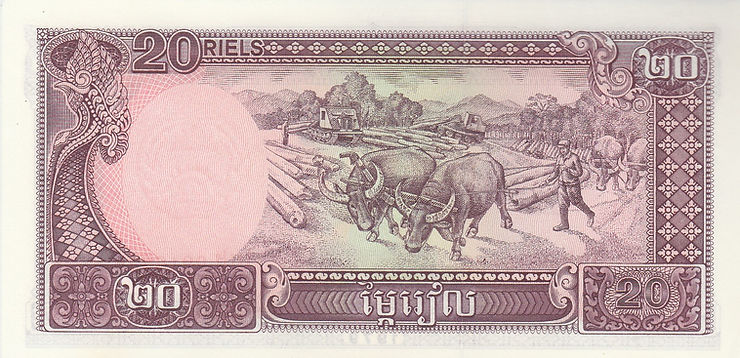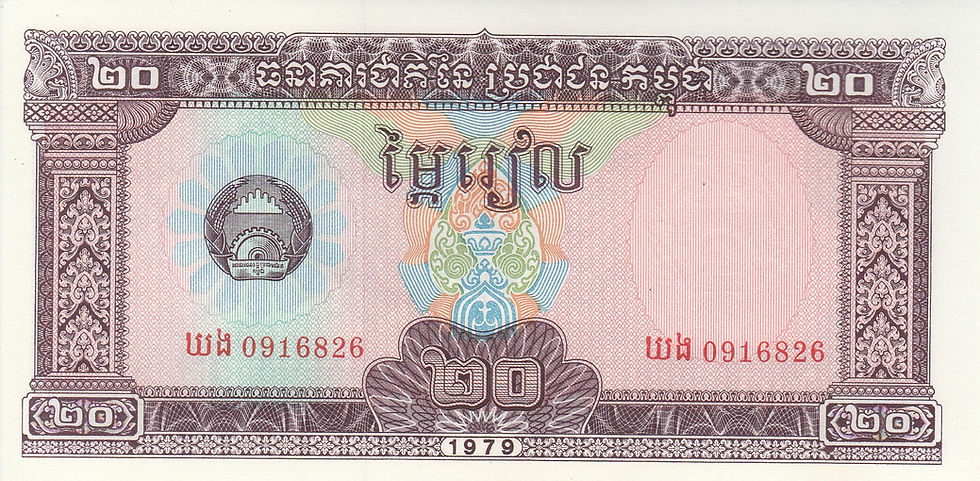Beasts Of Burden, Notes Of The Second Riel: 20 Riel (Cambodia, 1979)-Article
- smithwicknumismati
- Sep 26, 2021
- 4 min read
Updated: Apr 20, 2024
This Cambodian banknote represents the 7th denomination of the Second Riel (Seventh Issue, Series 1979). The Second Riel was introduced 1 April 1980, during the Vietnamese occupation of Cambodia. Which was in response to the Cambodian (Democratic Kampuchea) invasion of Vietnam. Beginning the drawn out Cambodian–Vietnamese War (1978-1989).
The Vietnamese successful counter-attack lead to the overthrow of the Khmer Rouge government. And the establishment of the People's Republic of Kampuchea (1979-1989). Notably the Second Riel was technically preceded by the Democratic Kampuchea Riel (Series 1975). Which were withdrawn and destroyed, due to the Khmer Rouge abolishing the concept of currency. (This note will be reviewed reverse first)
Reverse

The reverse depicts loggers using water buffalos to drag felled trees. In the background, Soviet-built TDT-40 transporters can be seen being loaded. This image is meant to contrast traditional and modern logging, to show economic and social progress. To the left is the note's watermark area, it features the State Emblem of the People's Republic of Kampuchea.
Beyond this image and watermark area is the notes decorative frame. Its design is heavily influence by Khmer temple architecture. To the note's far right, is design abstractly resembling a nāga. The nāgas are divine/semi-divine deities worshiped in Hinduism and Buddhism. They take the form of multi-headed cobras.
The reverse majority of the reverse text is Khmer script and numerals. The lower text reads "ម្ភៃរៀល", translated as "Twenty Riels". This is repeated on the lower-left and upper-right in Khmer numerals (๒๐), for the number "20". Which is listed in standard numerals, on the upper-left and lower-right. The upper left (20 Riels) is the only example of non-Khmer text.
Observe

The observe features a decorative multi-color design at it's center. To the center-right is the 1979 State Emblem of the People's Republic of Kampuchea. This is opposed to the lower denominations of the Seventh Issue Riels. Which feature the state emblem at the observe center. Opposite of the State Emblem is the watermark area, repeating the same image.
Notably nearly all text is printed Khmer script and numerals. The header reads "សាធារណរដ្ឋប្រជាមានិតកម្ពុជា", translated as the "PEOPLE'S REPUBLIC OF KAMPUCHEA". Below the header is additional text it reads, "ម្ភៃរៀល " for "Twenty Riels". While the footer list the note's print date "1979". Above the footer is the number 20, in Khmer numerals (๒๐).
Below the Nation Emblem and watermark area are the note's dual serial numbers. It reads "ឃង 0916826", roughly translated as "KhNg 0916826". Notably the Khmer alphabet does not directly translate to Latin/standard script.
Moving toward the ornate border, we can see a pair of 5-headed nāgas or Anontak. The heads symbolize the 5 manifestations of the Buddha. As Kadabak, Kunsontho, Koneakumno, Gautama Buddha and Seare Metrey. Along the notes corners are Khmer numerals (๒๐), they simply reaffirm the note's "20" Riels value.
The Asian Water Buffalo
The Asian Water Buffalo is economically and culturally significant in Southeast Asia. Particularly amongst rural farmers, often forming their most prized procession. Providing their owners with a source of heavy labor, fuel, and renewable food. Through their rich milk, which is processed into useful dairy products. Historically consumption of their meat was rare, often reserved for religious festivals.
Asian Water Buffalo is divided into distinct River and Swamp types. With each type domesticated independently, at different times and regions. The River Buffalo is believed to been domesticated in Western India 4,300 BCE. While the domestication Swamp Buffalo is more uncertain, Although is believe to have happened within Southeast Asia, sometime between 5,000-1,000 BCE.
The 2 water buffalo types differ in appearance and behavior. River Buffalo are black to dark slate in color, with long faces/legs, and upward curving horns. While Swamp Buffalo are gray to bluish gray, with swept back horns, wider faces, stocky legs, and large bellies. Their natural habit to wallow in mud better suits them for rice planting. As opposed to the larger and taller River Buffalo, who make better pack animals.
The smaller Swamp Buffalo is often considered the more manageable of the 2 types. To the extent children in Southeast Asia are capable of rending them in rice paddies. Children are often first trained with younger animals, which helps create better bonding. Similar to the family structure of Southeast Asia villages, buffalos are often bred amongst neighbors.
Both River and Swamp Buffalo dung is utilized as a natural fertilizer. It plays a particularly important role in rice farming. As buffalo dung adds vital nutrients to the soil, through its rich diet of aquatic plants. This diet it useful when clearing wetlands for rice cultivation, as its within buffalo's nature.
Notably Water Buffalo are also capable of consuming dry and non-aquatic plants. Buffalos used for dairy are often fed green fodders. Which includes fodders rich in sugars, which helps produce more disable milk. While recycling left over by-products, such as banana peels and sugar cane waste. Thus helping minimize local waste and in neighboring areas.
Water Buffalo have also been recently suggested to clear areas of evasive and overgrown aquatic plants. By using Water Buffalo in controlled grazes, to provided space for beneficial plant and wildlife. Thus providing a natural means of environmental conservation and restoration.
Second Riel (Series 1979) Gallery
(Gallery will be updated, as new banknotes are databased)
Additional Notes
The note's dimensions are 148 x 74 mm or 5.83 x 2.91 in, wider than a US Dollar.
This banknote is wider and shorter, than a standard US Dollar (6.14 x 2.61 in)
It's highly recommended to use large protective sleeves, when preserving this note.
The Second Riel uses the ISO code is KHR and "៛" as its symbol.
The Second Riel was sub-divided into 10 Kak/100 Sen, before rising inflation made these denominations obsolete.
Since the 1990s the US Dollar has been used as an accepted currency, in Cambodian retail.
Photo Credits
All non-currency related photos are provided by Wikimedia, support Copyleft License.
Support the free exchange of photos and other digital intellectual media.
The article's South Vietnamese Farmer photo is a public domain image via USIA.
This article's Albino Swamp Buffalo photo is is attributed to photographer Steve Jurvetson.
This article's boy and buffalo photo is is attributed to Wikimedia User Paulrudd.



































コメント